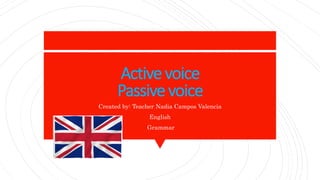
Active and passive voice.pptx
- 1. Activevoice Passive voice Created by: Teacher Nadia Campos Valencia English Grammar
- 2. Introduction Passive voice: Two cups of coffee were drunk. ( we can add by me, if we want, but it is not necessary). Let’s look at this sentence: I drank two cups of coffee. This is an active sentence and it has the subject first (the person or thing that does the verb), followed by the verb, and finally the object (the person or thing that the action happens to). So, in this example, the subject is 'I', the verb is 'drank' and the object is 'two cups of coffee'. But, we don't always need to make sentences this way. We might want to put the object first, or perhaps we don't want to say who did something.
- 3. Howto make thepassive voice? We make the passive by putting the verb 'to be' into whatever tense we need and then adding the past participle. For regular verbs, we make the past participle by adding 'ed' to the infinitive. So ‘play’ becomes ‘played’.
- 4. Examples
- 5. Verbs with two objects Some verbs that have two objects can make two different active sentences, and so two different passive sentences too. For example, the verb ‘give’ is like this: Active: He gave me the book / He gave the book to me. You can choose either of the two objects to be the subject of the passive sentence. Passive: I was given the book (by him)/ The book was given to me (by him). Other verbs like this are: ask, offer, teach, tell, lend, promise, sell, throw.
- 6. Thepassive in subordinate clauses You can make the passive in a subordinate clause that has a subject and a normal conjugated verb. This is really the same as a normal passive. Active: I thought that Mary had kissed John. Passive: I thought that John had been kissed by Mary. Active: He knew that people had built the church in 1915. Passive: He knew that the church had been built in 1915.
- 7. Extra info You can also make the passive using a passive gerund or a passive infinitive in the same place as a normal gerund or infinitive. The child loves being cuddled. She would like to be promoted.
- 8. So… Whenshould weusethe passivevoice? 1)When we want to change the focus of the sentence: The Mona Lisa was painted by Leonardo Da Vinci. (We are more interested in the painting than the artist in this sentence). 2) When who or what causes the action is unknown or unimportant or obvious or 'people in general’: He was arrested (obvious agent, the police). My bike has been stolen (unknown agent). The road is being repaired (unimportant agent). The form can be obtained from the post office (people in general).
- 9. 3) In factual or scientific writing: The chemical is placed in a test tube and the data entered into the computer. 4) In formal writing instead of using someone/ people/ they (these can be used in speaking or informal writing): The brochure will be finished next month.
- 10. 5) In order to put the new information at the end of the sentence to improve style: Three books are used regularly in the class. The books were written by Dr. Bell. ('Dr. Bell wrote the books' sound clumsy). 6) When the subject is very long: I was surprised by how well the students did in the test. (More natural than: 'how well the students did in the test surprised me’).
- 13. Board game